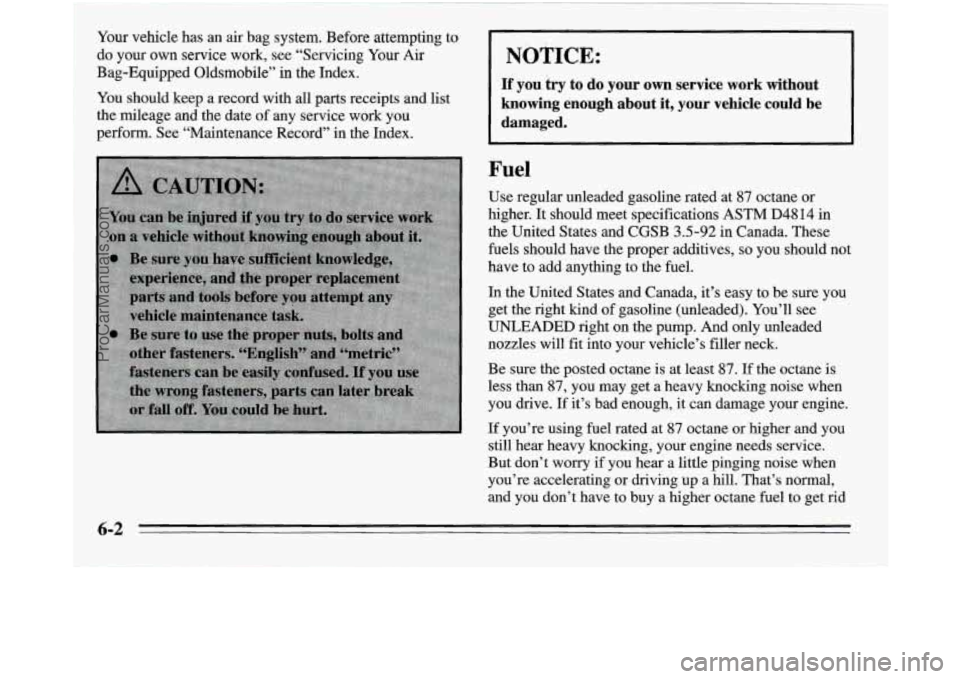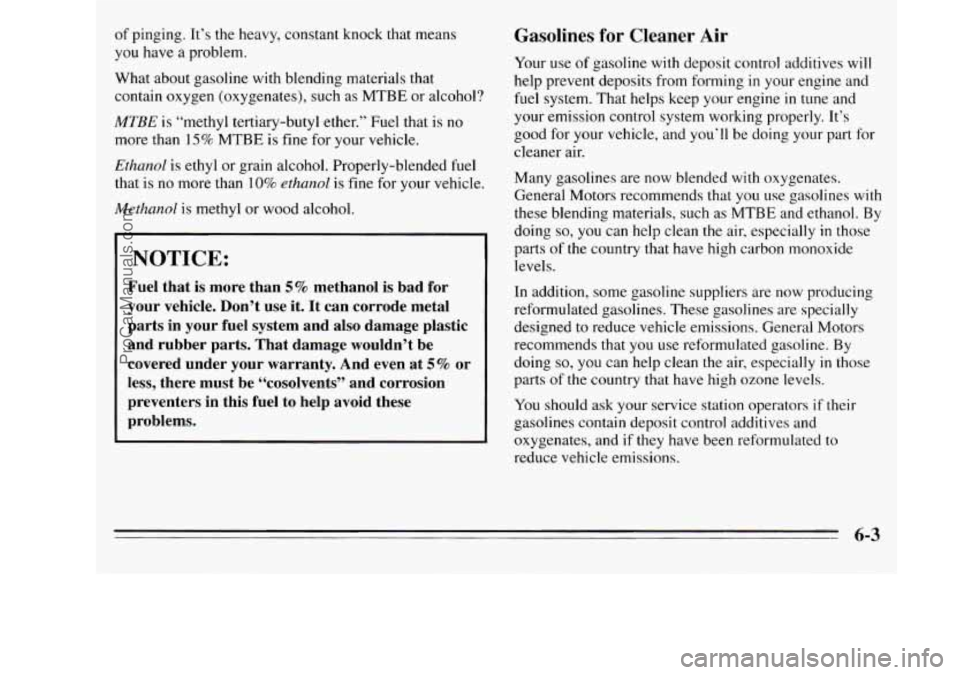Page 239 of 390
3800 V6: Cooling System
When you decide it’s safe to lift the hood, here’s what
you’ll see: If
the coolant inside the coolant recovery tank is boiling,
don’t do anything else until it cools down.
(A) Coolant recovery tank
(B) Radiator pressure cap
(C) Electric engine fan (or fans if you have the 3800 V6
engine).
3.1L V6: Recovery Tank Level
5-17
ProCarManuals.com
Page 240 of 390
3800 V6: Recovery Tank Level
l I I
The coolant level should be at or above the FULL HOT
mark. If it isn’t, you may have a leak in the radiator
hoses, heater hoses, radiator, water pump or somewhere
else in the cooling system.
I NOTICE:
Engine damage from running your engine
without coolant isn’t covered by your warranty.
If there seems to be no leak, with the engine on, check to
see if the electric engine fan is running.
If the engine is
overheating, the fan should be running.
If it isn’t, your
vehicle needs service.
5-18
ProCarManuals.com
Page 241 of 390
How to Add Coolant to the Coolant
Recovery Tank
If you haven’t found a problem yet, but the coolant
level isn’t at or above the
FULL HOT mark, add a
50/50 mixture of clean water (preferably distilled) and
a proper antifreeze at the coolant recovery tank. (See
“Engine Coolant” in the Index for more information
about the proper coolant
mix.)
NOTICE:
In cold weather, water can freeze and crack the
engine, radiator, heater core and other parts. Use
the recommended coolant.
When the coolant in the coolant recovery tank is at or
above the
FULL HOT mark, start your vehicle.
If the overheat warning continues, there’s one more
thing you can try. You can add the proper coolant mix
directly to the radiator, but be sure the cooling system
is
cool before you do it.
5-19
ProCarManuals.com
Page 244 of 390
3.lL V6: Upper Radiator Hose
5. plTt the cap back on the coolant recovery tank, but
leave .the radi@or pres- cap off.
3800 V6: Upper: *' Radiator Hose
6. Start the engine and let it run until you can $eel the
upper radiator hose getting hot. Watch out
for the
engine fan(
s) .
5-22
ProCarManuals.com
Page 262 of 390

Your vehicle has an air bag system. Before attempting to
do your own service work, see “Servicing Your Air
Bag-Equipped Oldsmobile”
in the Index.
You should keep a record with all parts receipts and list
the mileage and the date of any service work you
perform. See “Maintenance Record” in the Index.
~~ ~~~~~ ~~ ~
NOTICE:
If you try to do your own service work without
knowing enough about it,
your vehicle could be
I damaged. I
Fuel
Use regular unleaded gasoline rated at 87 octane or
higher. It should meet specifications ASTM D4814 in
the United States and CGSB
3.5-92 in Canada. These
fuels should have the proper additives, so you should not
have to add anything to the fuel.
In the United States and Canada, it’s easy to be sure you
get the right kind of gasoline (unleaded). You’ll see
UNLEADED right on the pump. And only unleaded
nozzles will fit into your vehicle’s filler neck.
Be sure the posted octane is at least
87, If the octane is
less than
87, you may get a heavy knocking noise when
you drive. If it’s bad enough, it can damage your engine.
If you’re using fuel rated at
87 octane or higher and you
still hear heavy knocking, your engine needs service.
But don’t worry if you hear a little pinging noise when
you’re accelerating or driving up a hill. That’s normal,
and you don’t have to buy a higher octane fuel to get rid
6-2
ProCarManuals.com
Page 263 of 390

of pinging. It’s the heavy, constant knock that means
you have
a problem.
What about gasoline with blending materials that
contain oxygen (oxygenates), such as
MTBE or alcohol?
MTBE is “methyl tertiary-butyl ether.” Fuel that is no
more than
15% MTBE is fine for your vehicle.
Ethanol is ethyl or grain alcohol. Properly-blended fuel
that is
no more than 10% ethanol is fine for your vehicle.
Methanol is methyl or wood alcohol.
I NOTICE:
Fuel that is more than 5% methanol is bad for
your vehicle. Don’t use it. It can corrode metal
parts in your fuel system and also damage plastic
and rubber parts. That damage wouldn’t be
covered under your warranty. And even at
5% or
less, there must be “cosolvents” and corrosion
preventers in this fuel to help avoid these
problems.
Gasolines for Cleaner Air
Your use of gasoline with deposit control additives will
help prevent deposits from forming
in your engine and
fuel system. That helps keep your engine
in tune and
your emission control system working properly. It’s
good for your vehicle, and you’ll be doing your
part for
cleaner air.
Many gasolines are now blended with oxygenates.
General Motors recommends that you use gasolines with
these blending materials, such as
MTBE and ethanol. By
doing
so, you can help clean the air, especially in those
parts of the country that have high carbon monoxide
levels.
In addition, some gasoline suppliers are now producing
reformulated gasolines. These gasolines are specially
designed to reduce vehicle emissions. General Motors
recommends that you use reformulated gasoline.
By
doing so, you can help clean the air, especially in those
parts of the country that have high ozone levels.
You should ask your service station operators
if their
gasolines contain deposit control additives and
oxygenates, and if they have been reformulated to
reduce vehicle emissions.
6-3
ProCarManuals.com
Page 264 of 390

~~~ Fuels in Foreign Countries
If
you plan on driving in another country outside the
United States or Canada, unleaded
fuel may be hard to
find. Do not use leaded gasoline.
If you use even one
tankful, your emission controls won’t work well or at
all. With continuous use, spark plugs can get fouled, the
exhaust system can corrode, and your engine oil can
deteriorate quickly. Your vehicle’s oxygen sensor will be
damaged. All of that means costly repairs that wouldn’t
be covered by your warranty.
To check on fuel availability, ask an auto club, or
contact a major oil company that does business in the
country where you’ll be driving.
You can also write us at the following address for
advice. Just tell us where you’re going and give your
Vehicle Identification Number (VIN).
General Motors Overseas Distribution Corporation,
North American Export Sales (NAES)
1908 Colonel Sam Drive
Oshawa, Ontario
L1H 8P7
Filling Your Tank
The cap is behind a hinged door on the driver’s side of
your vehicle.
You will notice that on the inside of the
hinged door there is a place to hold
the gas cap while
you are adding fuel.
6-4
ProCarManuals.com
Page 267 of 390
r
Go to the front of the vehicle and pull up on the outside
hood release.
Lift the hood. The
hood prop rod may be hot due to increased engine
temperatures under the hood,
so be careful when
handling it. Use your hood prop sleeve when handling
the prop.
Pull forward on the hood prop to release it from its
storage clip. Put the end
of the hood prop into the slot in
the underside of the hood.
6-7
ProCarManuals.com